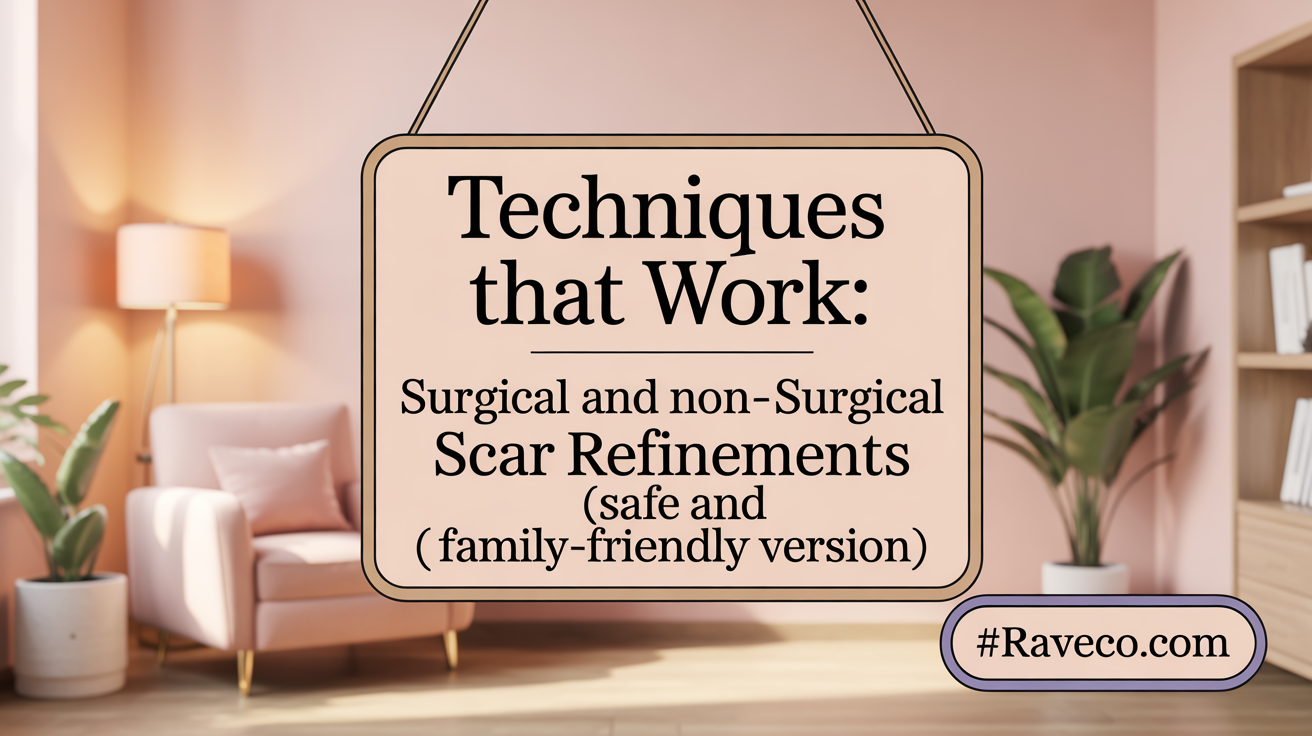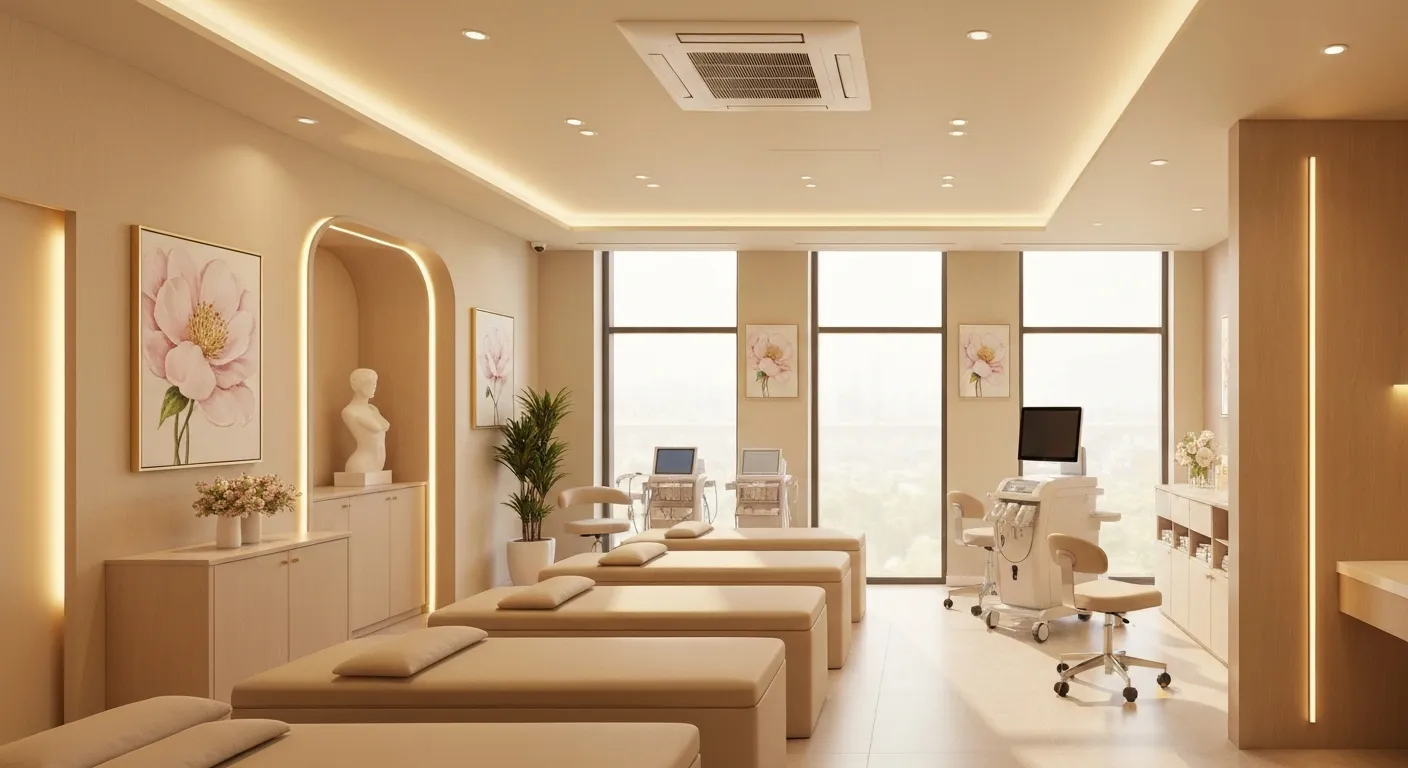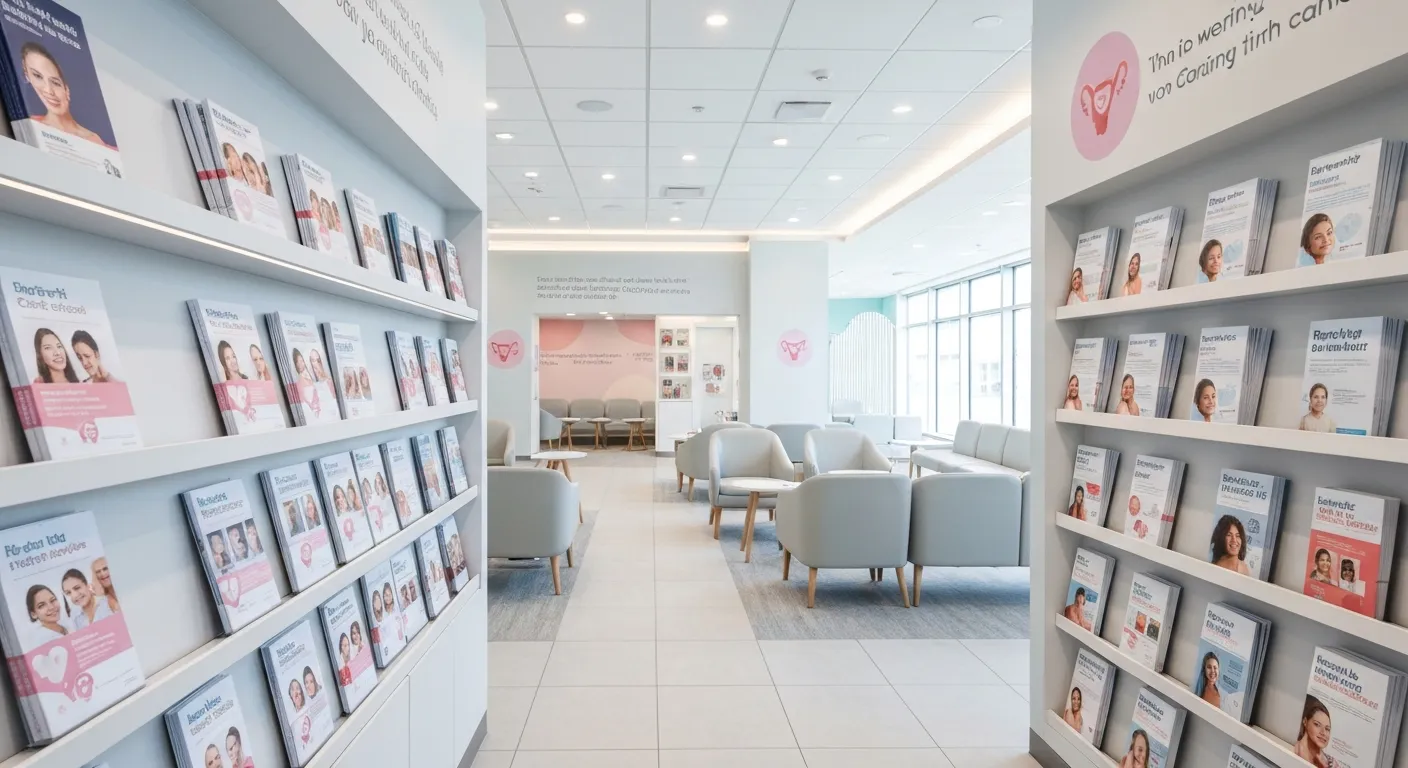Recognizing the Right Time to Address Female Infertility: Key Indicators and Expert Care in Queens

Understanding C-Section Scar Revision Outcomes
Cesarean section (C-section) scar revision is a critical aspect of postoperative care for many women seeking both symptomatic relief and cosmetic enhancement. This article delves into the statistical outcomes, satisfaction rates, cosmetic improvements, and effectiveness of various scar revision techniques. By synthesizing evidence-based clinical study data and patient-reported satisfaction, we aim to provide a comprehensive overview of the nuances affecting success in C-section scar revisions.
Statistical Outcomes of C-Section Scar Revision Procedures

What are the statistical outcomes of C-section scar revision procedures?
C-section scar revision procedures have shown promising results in improving both the cosmetic appearance and the functional outcomes of the scar. Clinical data indicate that most patients experience significant healing benefits, including better scar texture, color, and pliability. Objective assessments, such as ultrasound measurements, often reveal increased residual myometrial thickness—an important factor for uterine integrity—after revision surgery.
In a review of outcomes, over 70% of women reported reductions in scar indentation and improvement in overall appearance. Symptom relief is also notable; many patients experience a marked decrease in gynecological symptoms like postmenstrual spotting, pelvic discomfort, dysmenorrhea, and painful intercourse. These improvements contribute significantly to patient satisfaction.
The recurrence rate of cesarean scar defects after revision is relatively low, approximately 13%. Higher risks are associated with emergency C-sections, possibly due to less optimal initial incision healing. Importantly, no adverse events, such as uterine rupture, have been reported in subsequent pregnancies, highlighting the safety of these procedures when properly indicated.
Overall, statistical data support that targeted surgical repair effectively enhances scar quality, alleviates symptoms, and provides a safe pathway for future pregnancies, especially in carefully selected patients.
| Outcome Parameter | Results | Additional Details |
|---|---|---|
| Scar healing metrics | Over 70% improvement | Includes reduced indentation and better tissue integration |
| Symptom relief | Significant decrease in symptoms | Spotting, pain, dysmenorrhea, dyspareunia |
| Recurrence rates | Approximately 13% | Higher in emergency C-section cases |
| Subsequent pregnancies | No reported uterine ruptures | Indicates high safety when properly managed |
This evidence underscores the efficacy and safety of C-section scar revision, emphasizing the importance of appropriate patient selection and surgical technique to optimize outcomes.
Satisfaction Rates Associated with C-Section Scar Revision

What are the satisfaction rates associated with C-section scar revision?
Patient satisfaction following cesarean scar revision varies based on multiple factors, including the aesthetic and functional outcomes of the procedure. Current studies indicate that approximately 82% of patients report improved satisfaction after scar revision surgery. In detail, 81.78% of patients notice or experience better cosmetic results, while only about 2.34% feel worse about their scars post-treatment.
Satisfaction rates also depend on how well the scar aligns with natural skin lines and the psychological benefits gained. For example, patients whose scars are aligned parallel to Relaxed Skin Tension Lines report higher satisfaction levels, with rates reaching as high as 83%. Furthermore, functional improvements—such as enhanced self-care or reduced discomfort—contribute positively to overall satisfaction.
Patients’ psychological well-being plays a crucial role. Those who experience significant psychological benefits, like decreased anxiety over scar appearance or improved self-esteem, tend to report higher satisfaction. Specifically, about 89% of patients who experience psychological or functional benefits are satisfied with the outcome.
Overall, these satisfaction rates suggest that proper patient selection, surgical technique, and addressing psychological factors are essential for achieving desirable results. When combined with realistic expectations and appropriate interventions, most women can expect a positive perception of their scar revision outcomes.
Cosmetic Improvements After C-Section Scar Revision

What are the cosmetic results and improvements after C-section scar revision?
Patients undergoing C-section scar revision often seek to enhance the appearance of their scars, reducing their visibility and irregularities. The primary cosmetic goals include minimizing scar prominence, improving color, and correcting texture issues such as stiffness or unevenness.
Different methods are employed to achieve these improvements. Surgical techniques like scar excision and re-closure can significantly reduce scar length and irregularities, making the scar less conspicuous. Non-surgical approaches, such as laser therapy, silicone gels, and intralesional corticosteroids, are also effective in improving scar color, pliability, and surface smoothness.
Studies show that surgical scar revision can lead to a noticeable reduction in scar appearance, especially when combined with proper wound care and adjunct treatments. Laser treatments, particularly pulsed dye lasers, help diminish redness and improve scar texture, while topical treatments address superficial concerns.
Patient satisfaction varies but generally hinges on the extent of aesthetic improvement and scar characteristics. Many patients report high satisfaction levels, particularly when the scar blends well with adjoining skin and is less visible. Although completely invisible scars are rare, advancements in both surgical and non-surgical therapies now allow for significant aesthetic enhancement.
In summary, the combination of appropriate surgical techniques and adjunct therapies can substantially improve the cosmetic outcome of C-section scars, boosting confidence and overall satisfaction.
Effectiveness of Scar Revision Techniques for C-Section Scars

How effective are different scar revision techniques for C-section scars?
Scar revision methods aim to improve the appearance and feel of scars, especially those resulting from cesarean sections. Surgical approaches like Z-plasty, W-plasty, and excision involve rearranging scar tissue or removing problematic scar portions to change their orientation or reduce their prominence.
Non-surgical options include laser therapy, silicone gel sheets, and topical treatments. Laser treatments, particularly pulsed dye lasers, can reduce scar height, redness, and improve elasticity, providing notable cosmetic benefits. Silicone gels and sheets help modulate collagen production, leading to softer, flatter scars with minimal side effects.
Combining these techniques often yields better results. For example, surgery can be complemented with laser therapy or topical silicone application for a more refined appearance.
The effectiveness of scar revision varies depending on individual factors such as scar type, age, skin type, and timing of intervention. Generally, these methods do not completely erase the scar, but they can significantly improve its look and texture.
In summary, while no procedure guarantees total removal, a tailored approach combining surgical, laser, and topical treatments can produce satisfactory cosmetic outcomes, making scars less visible and more harmonious with surrounding skin.
Patient Perceptions and Their Influence on Satisfaction After C-Section Scar Revision
How do patient perceptions relate to satisfaction following C-section scar revision?
Patient perceptions of their scars play a vital role in their overall satisfaction after revision procedures. Many women who undergo scar revision report that their satisfaction is influenced not just by the actual appearance of the scar, but also by psychological factors such as self-esteem, confidence, and social acceptance.
Improvements in scar appearance often lead to a reduction in negative feelings like embarrassment or self-consciousness. This can enhance psychological well-being, decreasing feelings of anxiety and depression associated with visible scars. The link between scar appearance and mental state means that patients who perceive their scars as more aesthetically pleasing are generally more satisfied with the outcome.
Furthermore, how patients view their scars impacts their quality of life. For example, women with traumatic scars, which tend to have a more irregular appearance, often report higher satisfaction rates after revision, especially when their scars become less conspicuous.
The choice of skin closure method during cesarean sections also influences perception. Studies indicate that subcuticular sutures generally yield better aesthetic outcomes and higher patient satisfaction compared to staples, which can sometimes cause more noticeable scars.
In addition, adjunct treatments like platelet-rich plasma (PRP) injections have been shown to improve scar texture and color, which further enhances patient perception and satisfaction. Improved appearance and better social interactions contribute significantly to overall happiness following scar revision.
Patient perceptions are not solely about physical appearance but also involve the psychological benefits gained from improved self-image and confidence. These multidimensional perceptions ultimately determine the level of satisfaction women feel about their scars after surgical revision.
In summary, positive perceptions related to scar appearance and psychological well-being are interconnected, and both strongly influence patient satisfaction after cesarean scar revision. Addressing both aesthetic and emotional aspects ensures a more holistic approach to scar management, leading to higher satisfaction rates.
Comparative Data on Surgical Methods in C-Section Scar Management
When it comes to managing cesarean section (C-section) scars, a variety of surgical approaches have been evaluated to determine which methods offer the best outcomes for patients. Different techniques have distinct advantages and potential risks, making the choice largely dependent on the individual patient’s scar type and overall condition.
A comprehensive study involving 314 cases provided valuable insights into the effectiveness of various surgical techniques. The procedures examined included curettage with pituitrin under ultrasonic monitoring, curettage following methotrexate injection, and more invasive options like laparoscopic or transvaginal/transabdominal resection.
In this comparison, curettage combined with pituitrin injection demonstrated high effectiveness, particularly in treating type I and II cesarean scar pregnancies. Patients undergoing these procedures experienced less intraoperative bleeding, shorter hospital stays, and higher success rates in subsequent pregnancies. This method proved to be efficient, especially when used with ultrasonic guidance to minimize risks.
Laparoscopic surgery, on the other hand, was more suitable for more complex cases such as type III cesarean scar pregnancy. Although it allowed for precise scar removal and correction, it involved higher risks, including increased operative time, potential complications, and greater expenses. The approach is typically reserved for cases where minimally invasive procedures are preferred or when other methods have failed.
Further large-scale analysis on 1248 women categorized into specific subtypes of cesarean scar pregnancy reinforced these findings. The success rate across different treatments averaged around 95.5%, emphasizing that tailoring surgical choice based on the classification of the scar and pregnancy type produces optimal outcomes.
Summary table of surgical methods and outcomes:
| Surgical Method | Best Suited For | Benefits | Risks/Considerations | Success Rate (%) | Additional Notes |
|---|---|---|---|---|---|
| Curettage + Pituitrin (ultrasound guidance) | Type I and II CSP | Less bleeding, shorter recovery, high success | Operator dependency, requires ultrasound | >95 | Effective for early cases |
| Curettage after methotrexate injection | Selected cases | Less invasive, preserves uterine integrity | Potential systemic effects of methotrexate | Not specified | Suitable for medication-assisted treatment |
| Laparoscopic resection | Type III CSP | Precise scar removal, appropriate for complex cases | Higher costs, operative risks | High | Allows detailed visualization |
The importance of selecting the appropriate surgical method is underscored by its direct impact on outcomes like intraoperative blood loss, hospitalization duration, and success in subsequent pregnancies. Overall, evidence favors a tailored approach based on the specific scar type, pregnancy classification, and patient health to ensure safe and effective management of cesarean scars.
Long-Term Success and Impacts of C-Section Scar Revision
What are the long-term impacts and success statistics for C-section scar revision?
C-section scar revision procedures generally yield positive long-term outcomes, particularly in symptom relief and reproductive health. Surgical techniques such as laparoscopic niche repair have shown high success rates, with approximately 77% of women experiencing significant symptom improvement. These procedures aim to alleviate issues like abnormal bleeding, pain, and secondary infertility caused by scar lesions.
Regarding fertility and pregnancy, data indicate that about 81.1% of women who undergo cesarean scar management after revision are able to conceive again. Most of these pregnancies are carried to full term via cesarean delivery, with neonatal outcomes generally favorable, reflecting a safe postpartum course.
The recurrence of cesarean scar pregnancy (CSP) post-treatment occurs in roughly 10% of cases. Nevertheless, successful pregnancy attempts following revisions show encouraging statistics, with live birth rates reaching approximately 78.4%. This suggests that while some risk of recurrence exists, effective management and careful monitoring can facilitate healthy pregnancies.
Safety profiles for these revisions are favorable, with minimal adverse events reported. Factors such as the number of previous cesarean deliveries can influence the likelihood of recurrence, emphasizing the importance of individualized patient assessment. Overall, scar revision techniques not only improve aesthetic concerns but also support reproductive function, with most women experiencing durable symptom relief.
| Aspect | Statistic | Notes |
|---|---|---|
| Symptom relief rate | About 77% | Based on surgical correction success |
| Pregnancy rate post-revision | Approximately 81.1% | Conception success after scar management |
| Live birth rate | Around 78.4% | Favorable neonatal outcomes |
| Recurrent CSP | About 10% | Re-scar pregnancy occurrence |
| Safety profile | Minimal adverse events | Generally well tolerated |
Clinical Study Evidence on C-Section Scar Revision Outcomes
What evidence-based results and clinical study data are available on C-section scar revision outcomes?
Research on cesarean section scar revision provides promising insights into improving both cosmetic and functional outcomes. Surgical techniques like laparoscopic niche resection have been studied extensively for their safety and effectiveness. These procedures have shown to alleviate symptoms such as abnormal bleeding, pain, and uterine discomfort, with about 77% of patients experiencing symptom relief.
Reproductive benefits are also significant. Data suggest that approximately 73% of women undergoing scar revision become pregnant after the procedure. Among those conceiving, the live birth rate is around 60%, highlighting the potential for restoring fertility. A notable retrospective cohort study from Amsterdam reported that over 81% of women achieved subsequent pregnancy, with nearly 78% resulting in live births safely.
Safety profiles are favorable, with no major complications like uterine rupture observed in the reviewed cases. The procedures often increase residual myometrial thickness, reducing the risk of uterine rupture in future pregnancies and supporting the overall safety of surgical correction.
In summary, evidence supports that targeted surgical repair of cesarean scar defects can significantly enhance symptom management and reproductive capacity. Continuous follow-up studies affirm the safety profile and positive clinical outcomes associated with these interventions, making them a viable option for women seeking correction of their cesarean scar issues.
Comparison of Suturing Techniques on Scar Outcomes
Subcuticular sutures vs intradermal buried sutures
In a recent study comparing different suturing methods for cesarean section scars, researchers evaluated the cosmetic results of subcuticular sutures against intradermal buried sutures. The study examined a total of 303 cesarean deliveries, with 102 patients completing follow-up surveys.
The results showed that scars closed with intradermal buried sutures tended to look better overall. The mean Patient and Observer Scar Assessment Scale (POSAS) score for this group was 21.8, indicating fewer scar-related concerns, compared to 28 in the subcuticular suture group. This difference was statistically significant, with a P-value of 0.02.
Results from the Patient and Observer Scar Assessment Scale (POSAS)
The POSAS was utilized to provide an objective measure of scar quality, considering both patient and observer perspectives. The intradermal buried suture group scored notably lower (better) in parameters such as scar color, stiffness, and thickness. These aspects contribute to the overall perception of a more refined and less noticeable scar.
Impact on scar characteristics such as color and thickness
Scar color and thickness are critical features influencing aesthetic satisfaction. The study found these parameters to be significantly improved in the intradermal buried sutures group. Patients and clinicians observed less discoloration and a more uniform scar. These improvements can enhance patient confidence and reduce the psychosocial impact of scarring.
Patient satisfaction correlation with scar appearance
Interestingly, while objective measures favored the intradermal method, overall patient satisfaction rates did not differ substantially between the two groups. A strong negative correlation (Pearson’s r = -0.63, P < 0.01) was noted between POSAS scores and patient satisfaction, emphasizing that better scar appearance generally aligned with higher satisfaction.
| Suturing Method | Mean POSAS Score | Key Characteristics Improved | Significance |
|---|---|---|---|
| Intradermal Buried | 21.8 | Color, stiffness, thickness | P=0.02 |
| Subcuticular | 28 | - | - |
This comparison underscores the potential benefits of intradermal buried sutures in achieving superior scar appearance, although patient satisfaction remains influenced by multiple factors beyond objective scar assessment.
Impact of Skin Closure Methods on Repeat Cesarean Scars
Tissue adhesive versus metal staples
In repeat cesarean sections, the choice of skin closure method can influence scar appearance and healing. A recent study compared tissue adhesive and metal staples in 66 women, evaluating scars at 2 and 6 months after surgery. Both methods showed comparable results, with no significant differences in cosmetic appearance or complication rates. This suggests that tissue adhesive, a less invasive option, may be as effective as traditional staples.
Scar cosmesis at 2 and 6 months post-op
Scar assessment employed validated scales like the Vancouver Scar Scale and the Patient and Observer Scar Assessment Scale (POSAS). Results indicated that neither closure technique resulted in superior cosmesis; scars appeared similar in height, color, and texture after both 2 and 6 months. Most scars were rated as minimally visible or invisible by both patients and clinicians, reflecting satisfactory cosmetic outcomes.
Complication rates including wound dehiscence
While overall cosmetic outcomes were similar, wound complications were rare. In one case involving tissue adhesive, partial wound dehiscence occurred. There were no significant differences in infection or bleeding between the two groups, confirming that both methods are generally safe.
Patient and observer scar ratings consistency
The study also explored how patient perceptions aligned with clinician evaluations. A moderate correlation was observed between the two groups’ ratings, indicating that patient satisfaction generally matched clinical assessments. This consistency further supports the reliability of using simple, effective closure methods like tissue adhesive without compromising scar quality.
Overall, the findings highlight that tissue adhesive and staples are both viable options for skin closure in repeat cesarean sections. Selecting between them can depend on surgeon preference and patient-specific factors without affecting scar outcome or safety.
Scar Revision Satisfaction Outcomes Across Scar Types and Demographics
How do satisfaction rates differ between traumatic and elective scars?
Patients with traumatic scars tend to report higher satisfaction rates following scar revision surgery, with about 91.8% expressing improved outcomes. In comparison, those with scars from elective procedures report a satisfaction rate around 77.8%. This difference suggests that scars resulting from trauma may respond better to revision or be perceived more positively after treatment.
Are there gender differences in satisfaction after scar revision?
Gender appears to influence satisfaction outcomes, with women reporting significantly better results. Approximately 85.5% of female patients express satisfaction, compared to about 75.4% of males. This variation might be related to differences in skin properties, aesthetic concerns, or expectations.
How are satisfaction outcomes distributed across different body sites?
Satisfaction rates are relatively consistent regardless of the scar's location on the body. The most common areas for revision include head and neck (34.1%), chest and axilla (23.8%), and abdomen (17.8%). Success tends to depend more on proper patient selection and scar management than on the body site.
Do functional or cosmetic reasons affect satisfaction outcomes?
Patients seeking scar revision for functional or symptomatic issues report similar satisfaction rates compared to those aiming for cosmetic improvement. The overall success appears to be largely independent of the initial indication, emphasizing the importance of proper assessment and techniques tailored to individual needs.
| Aspect | Satisfaction Rate | Additional Notes |
|---|---|---|
| Traumatic scars | 91.8% | Higher satisfaction associated with trauma-related scars |
| Elective scars | 77.8% | Slightly lower satisfaction, possibly due to different scar characteristics |
| Females | 85.5% | Tend to report higher satisfaction |
| Males | 75.4% | Slightly lower satisfaction |
| Head and neck | Data not distinct | Most common site, outcomes similar across sites |
| Chest and axilla | Data not distinct | Similar satisfaction rates |
| Functional/symptomatic reasons | Data not distinct | Satisfaction not significantly affected |
| Cosmetic reasons | Data not distinct | Outcomes comparable |
These findings highlight that careful patient selection and appropriate surgical techniques are vital for achieving satisfying results across different scar types, locations, and patient demographics.
Psychosocial Impact of C-Section Scars and Functional Limitations

How does dissatisfaction with scar appearance affect interpersonal interactions?
Many women experience dissatisfaction with their cesarean section (C-section) scars, which can influence their social and personal relationships. The study reveals a significant correlation between poor scar aesthetics and decreased confidence in social settings. Women who perceive their scars as irregular or discolored often report feeling embarrassed or self-conscious when engaging with others, impacting their interpersonal interactions.
How does scar appearance influence self-care activities?
Scar characteristics such as irregularity, pigmentation, and discomfort can interfere with daily self-care routines. Women reported difficulties in choosing swimwear, lingerie, or clothing that reveals the scar area, leading to feelings of insecurity and social withdrawal. The impact on activities like bathing or applying topical treatments further diminishes quality of life, highlighting the importance of aesthetic satisfaction for daily well-being.
What is the relationship between scar features and psychological well-being?
The study indicates that unfavorable scar features, including hypertrophic or pigmented scars, are linked to lower psychological well-being. Women with visible and irregular scars often experience emotional distress, decreased self-esteem, and social anxiety. Conversely, scars that are less noticeable tend to have minimal psychological impact, emphasizing the role of appearance in overall mental health.
How does scar aesthetics relate to overall quality of life?
The cosmetic outcome of a scar significantly influences a woman's quality of life. Aesthetic satisfaction correlates strongly with reduced psychological stress and improved self-perception. Better scar appearance fosters greater confidence and social participation, ultimately enhancing daily functioning. Ensuring favorable cosmetic results through appropriate surgical techniques and post-operative care is vital for improving long-term psychosocial outcomes.
| Aspect | Effect | Additional Context |
|---|---|---|
| Interpersonal interactions | Dissatisfaction can lead to social withdrawal | Feelings of embarrassment reduce social engagement |
| Self-care routines | Scar appearance affects clothing choices and hygiene practices | Discomfort may limit activities like bathing or applying medications |
| Psychological well-being | Poor scar aesthetics linked to emotional distress | Lower self-esteem, anxiety, and depression risk |
| Overall quality of life | Cosmetic satisfaction impacts daily functioning | Better scars promote confidence and social participation |
Emerging and Adjunctive Therapies in Scar Revision
How are intralesional corticosteroids and fluorouracil used in scar treatment?
Intralesional corticosteroids, such as triamcinolone acetonide, are frequently employed to treat hypertrophic scars and keloids. They work by inhibiting fibroblast proliferation and reducing collagen synthesis, which helps flatten and soften raised scars. Patients often receive injections at regular intervals, with studies showing that more than 50% of scar volume can decrease after at least 8 weeks of treatment.
Fluorouracil, a chemotherapeutic agent, has also shown promise in managing hypertrophic scars and keloids. It targets rapidly dividing fibroblasts, thereby decreasing excessive collagen production. When combined with corticosteroids, fluorouracil can accelerate scar flattening, reduce recurrence rates, and minimize adverse effects like skin atrophy or hypopigmentation. This combination therapy is gaining popularity for its effectiveness and safety.
What is the role of laser therapy, particularly the 585-nm pulsed dye laser?
Laser therapy, especially with the 585-nm pulsed dye laser (PDL), is renowned for improving scar appearance. The PDL targets vascular components within scars, reducing erythema and height. Higher fluences and shorter pulse durations are often more effective in diminishing scar thickness and vascularity.
Patients undergoing laser treatment typically see improvements in scar contour, color, and pliability within weeks. Laser therapy is non-invasive, with minimal downtime, making it a preferred option for many patients seeking aesthetic correction or symptom relief.
How does topical imiquimod cream help in preventing keloid recurrence?
Imiquimod 5% cream is a topical immune response modifier that has been used post-surgically to prevent keloid and hypertrophic scar recurrence. It acts by stimulating the body's immune system, which can modulate the wound healing process.
Studies suggest that applying imiquimod for periods ranging from 6 to 24 weeks can significantly lower the chance of scar regrowth. However, results vary, and further research is needed to establish standardized treatment protocols. It remains an adjunctive option for high-risk scars.
What is the potential of newer agents like ACE inhibitors and TGF-β3?
Emerging therapies such as ACE inhibitors (e.g., enalapril) are being investigated for their potential to reduce excessive scarring. These medications may interfere with mechanisms involved in fibrotic tissue formation, but current evidence is preliminary.
Similarly, TGF-β3, a growth factor variant, has shown in early clinical trials to improve scar quality by modulating collagen organization and reducing fibrosis. Topical or gene-based delivery of TGF-β3 could revolutionize scar management, though these options are still experimental.
Overall, ongoing research into these novel agents holds promise for more effective and less invasive scar revision methods.
| Therapy Type | Main Use | Effectiveness | Notes |
|---|---|---|---|
| Corticosteroids | Hypertrophic scars/Keloids | >50% volume reduction after 8 weeks | Injections, reduces collagen |
| Fluorouracil | Keloid reduction | Significant scar flattening when combined | Adjunct to corticosteroids |
| PDL Laser | Vascular scar improvement | Clear reduction in erythema and height | Used in early or mature scars |
| Imiquimod | Keloid prevention | Lower recurrence rates | Topical application post-surgery |
| ACE inhibitors | Scar modulation | Promising in trials | Still experimental |
| TGF-β3 | Scar quality enhancement | Improved collagen organization | Experimental, potential future therapy |
This suite of emerging and adjunctive therapies continues to expand, offering hope for more targeted, effective, and minimally invasive scar treatments in the future.
Non-Surgical Treatment Modalities for Improving Scar Quality
Silicone Gel Sheets and Topical Gels
Silicone therapy remains a widely used option for managing scars, including those from cesarean sections. Silicone gel sheets and topical gels work by creating a protective film over the scar, which helps to hydrate the tissue, modulate collagen production, and reduce redness. Clinical studies consistently report improvements in scar thickness, color, and overall appearance. Patients generally experience mild skin irritation as a side effect, but these treatments are well tolerated and non-invasive.
Pressure Therapy Benefits and Mechanisms
Pressure therapy is another non-surgical approach that effectively reduces hypertrophic scar height. It involves applying pressure to the scar area, which decreases blood flow and fibroblast proliferation—two factors crucial to scar hypertrophy. This method is often recommended for large or raised scars and can be used in combination with other treatments. When used consistently over several months, pressure therapy can lead to noticeable flattening and softening of the scar.
Radiotherapy for Keloid Prevention
Postoperative radiotherapy is an effective preventative measure against keloid recurrence, especially in high-risk patients. By controlling collagen synthesis and fibroblast activity, radiotherapy can significantly reduce the chance of keloid reformation after scar revision. High relapse-free rates of up to 80% have been documented over a five-year follow-up, making it a valuable option for persistent or recurrent keloids. However, it is typically reserved for severe cases due to concerns about radiation exposure.
Clinical Outcomes and Side-Effect Profiles
Overall, non-surgical treatments like silicone therapy, pressure application, and radiotherapy have demonstrated favorable safety profiles. Common side effects include mild skin irritation or discoloration, which are generally reversible. These modalities can substantially improve the aesthetic and functional aspects of scars, contributing to higher patient satisfaction, particularly when tailored to individual needs and combined with appropriate timing and application.
| Modality | Effectiveness | Side Effects | Suitable For |
|---|---|---|---|
| Silicone gel sheets/gels | Reduce thickness, redness, scars | Mild irritation, dryness | All types of scars, especially early |
| Pressure therapy | Flatten hypertrophic scars | Discomfort, skin indentation | Large, raised scars |
| Radiotherapy | Prevent recurrence of keloids | Possible skin changes, rare secondary malignancy | Recurrent, severe keloids |
Surgical Techniques for Structural Scar Revision
How effective are various surgical techniques such as Z-plasty, W-plasty, and geometric broken line closures?
Surgical scar revision often involves techniques like Z-plasty, W-plasty, and geometric broken-line closures. These methods are designed to improve the appearance of scars by changing their orientation, relieving tension, and camouflaging irregularities.
Z-plasty, for instance, reorients a scar to a less conspicuous direction, which can help reduce visibility and minimize contracture. W-plasty creates a zigzag line that breaks up the linear appearance of scars, making them less noticeable.
Geometric broken-line closures involve designing scars in specific patterns that disrupt the linearity and help integrate the scar with surrounding skin, especially beneficial in areas with contracture or prominent scars.
Clinical outcomes have shown these techniques to be effective in correcting aesthetic and functional issues. They are often combined with other procedures like dermabrasion for improved results.
How does dermabrasion contribute to scar improvement, and when should it be performed?
Dermabrasion is a minimally invasive procedure that smooths irregular or raised scars by removing the top layers of skin. It is especially effective on hypertrophic or irregular scars, providing a more even skin surface.
Typical improvements become evident around 6 to 8 weeks post-treatment, allowing sufficient healing time. It is generally recommended after initial scar revision procedures to refine contour and texture.
Prophylactic antiviral medication can reduce the risk of herpes simplex virus reactivation during dermabrasion, especially on facial scars.
Timing is crucial; performing dermabrasion after wound maturation—usually at least a few months post-surgery—ensures better outcomes and reduces complication risks.
How can scars be camouflaged or their direction changed to minimize their visibility?
Camouflaging scars involves strategic scar revision techniques that redirect the scar along natural skin lines or less visible areas. Changing scar direction through methods like Z-plasty or geometric breaks can significantly decrease their conspicuousness.
These techniques help blend scars with the surrounding tissue, making them less noticeable, especially in high-visibility regions such as the face or neck.
In addition, combining these with skin-tone matching, pigmentation treatments, or pigmentation correction enhances aesthetic outcomes.
What postoperative care protocols are essential to optimize scar appearance?
Postoperative care is vital in achieving the best scar outcomes. This includes proper wound care—keeping the area clean and moisturized—and avoiding tension on the wound.
Using silicone gel sheets or topical silicone gels during healing can reduce scar thickness and redness.
Sun protection prevents pigmentation changes and further discoloration of the scar. Additionally, patient adherence to activity restrictions and follow-up visits help identify and manage complications early.
Finally, adjunct therapies like laser treatments or injections may be utilized postoperatively to improve scar appearance over time.
| Technique | Purpose | Expected Outcomes | Additional Notes |
|---|---|---|---|
| Z-plasty | Reorient scar, relieve tension | Less visible scars, reduced contracture | Best for contracture release |
| W-plasty | Break linear scar appearance | Camouflage scar | Suitable for facial scars |
| Geometric closures | Disrupt linearity, camouflage | Improved esthetic blending | Often used in complex scars |
| Dermabrasion | Resurface irregular scars | Smoother skin surface | Performed after scar maturation, 6-8 weeks post |
Effective scar revision relies on appropriate technique selection, timing, and diligent postoperative care to ensure that scars become as inconspicuous and functionally acceptable as possible.
Summary and Future Directions in C-Section Scar Revision
C-section scar revision has demonstrated meaningful improvements in both the cosmetic appearance and patient satisfaction, supported by substantial clinical evidence. Surgical and non-surgical modalities each play crucial roles, with tailored approaches optimizing outcomes based on scar type and patient factors. Long-term data validate the safety and effectiveness of revision procedures, emphasizing their importance in restoring function and quality of life. Emerging therapies promise further advancements, while psychosocial benefits underscore the holistic value of scar management. Future research, particularly multicenter and large-scale studies, is essential to refine techniques and expand evidence-based guidance, ensuring optimal care for women seeking C-section scar revision.
References
- Cosmetic outcomes of cesarean section scar; subcuticular suture ...
- Cosmetic outcomes of skin closure with tissue adhesive or staples in ...
- Cosmetic outcomes of various skin closure methods following ...
- Scar Revision Surgery: The Patient's Perspective - ResearchGate
- Scar Revision Surgery: The Patient's Perspective - Thieme Connect
- [PDF] a cross-sectional analysis of the long-term clinical and functional ...
- a comparative study on the maternal and neonatal outcomes of mini ...





.png)